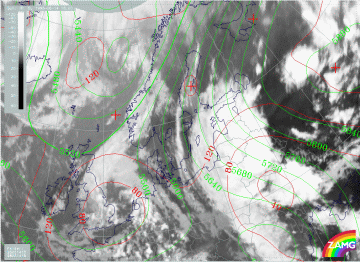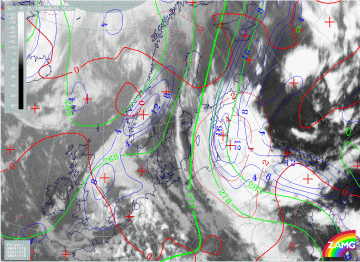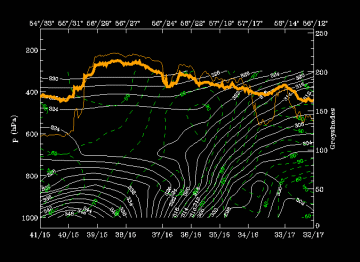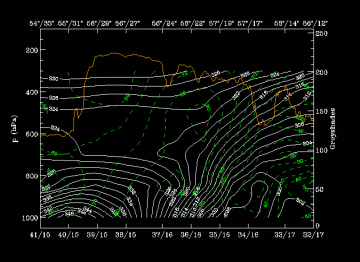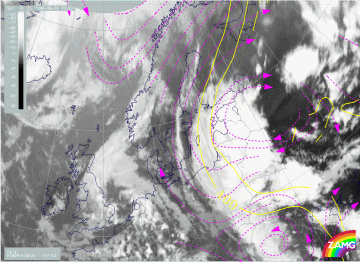14 June/18.00 UTC: Frontal diagnosis
Satellite Overview
We continue with a more thorough analysis of the frontal cloud bands from 14 June 06.00 UTC. By 18.00 UTC a Warm Front cloud band is stretching from Poland over White Russia to the Baltic States and Finland (H33a). Precipitation is observed within the southern part of the Warm Front and many thunderstorms were reported along the eastern parts of the Warm Front.
|
14 June 1998/18.00 UTC - Meteosat IR image; weather events (green: rain and showers, blue: drizzle, cyan: snow, red: thunderstorm with
precipitation, purple: freezing rain, orange: hail, black: no actual precipitation or thunderstorm with precipitation)
|
|
Parameters on isobaric surfaces
In Fig. H34 there is a distinct WV band over Finland with a sharp edge to a darker stripe over Sweden. The zero line of shear vorticity lies close to this westward boundary but approximately 1 - 2 degrees more to the east. The transition between tropospheric and stratospheric air at 300 hPa is very close to the sharp WV boundary. The eastward displacement of the zero line of shear vorticity when compared to the dry stripe in WV does not match the classical ideas, and could be interpreted as a model error.
|
14 June 1998/18.00 UTC - Meteosat WV image; red: height of PV=2 units, black: shear vorticity 300 hPa
|
|
In 12 hours the surface low at 50N/28W has intensified and there is a strong upper level southerly flow above (H35). The cloudiness over Poland, Baltic States and Finland clearly shows the Warm Frontal character. The Cold Front cloudiness over Romania and the Black Sea is very disorganized. The upper level trough over Romania has been cut off to form an Upper Level Low, which is an untypical development for a Cold Front. The cloudiness within the Baroclinic Boundary and the upper level trough existed before the surface low developed. It is more a reformation of cloud structures rather than a new development.
|
14 June 1998/18.00 UTC - Meteosat IR image; red: height contours 1000 hPa, green: height contours 500 hPa
|
|
In Fig. H36 a zone of high thickness gradient to the rear of the CF area, but within the WF cloudiness, is noticeable. The TFP lies at leading edge of the thickness gradient. The TFP is located within WF cloudiness, however, the more eastern higher cloud patches are associated with the unstable development, not with a frontal system. An intensive WA maximum over the WF cloud band extends into the unstable areas behind the front. The zero line of warm advection crosses the centre of the surface low (see H35), which is very typical at this stage of development.
|
14 June 1998/18.00 UTC - Meteosat IR image; blue: thermal front parameter (TFP) 500/850 hPa, green: equivalent thickness 500/850 hPa,
red: temperature advection - CA 1000 hPa
|
|
Vertical Cross Sections
The vertical cross-section line lies perpendicular to the Warm Front cloud band and its unstable areas. The orientation lies close to east to west (H37).
|
14 June 1998/18.00 UTC - Meteosat IR image; position of vertical cross section indicated
|
|
Isentropes and satellite pixel values:
There are two interesting areas in the isentropes (Fig. H38):
- An extremely unstable air mass from the surface up to 650 hPa east of the WF and
- A distinct WF zone with high gradients from the surface, at approximately 56N/23E, up to 300 hPa over 56N/12E.
A broad peak of highest IR and WV values lies over the unstable area and somewhat lower values on top of the WF. A separate peak at 56N/15E belongs to the cloud fibre at the western boundary of the WV band.
Relative humidity:
A zone of high humidity values (90 %) is situated over the Warm Fronts zone (H38). The lowest values (20 - 30%) appear below the frontal zone (below 304K at 56N/14E). This is to be expected in a Warm Front of band type.
|
14 June 1998/18.00 UTC - Vertical cross section; white: isentropes (ThetaE), green: relative humidity, orange thin: IR pixel values,
orange thick: WV pixel values
|
|
Warm advection:
In Fig. H39 warm advection dominates the vertical cross section with highest values within the WF zone. There are high values also in the area of the unstable air, but only up to 700 hPa. Not a typical distribution of warm advection in a Warm Front.
|
14 June 1998/18.00 UTC - Vertical cross section; white: isentropes (ThetaE), green thin: temperature advection - CA, green thick:
temperature advection - WA, orange thin: IR pixel values, orange thick: WV pixel values
|
|
Convergence:
The convergence field in Fig. H40 is not pronounced. The only region indicating a frontal convergence zone is the lowest layer of the WF at 850 hPa around 56N/22E, but even there it is quite weak. Even so it also has some of the qualities of a Warm Front cloud band.
|
14 June 1998/18.00 UTC - Vertical cross section; white: isentropes (ThetaE), green thin: divergence, green thick: convergence, orange
thin: IR pixel values, orange thick: WV pixel values
|
|
Vertical motion:
An extensive zone of upward motion is located on the WF as well as to the rear, above the unstable area (H41). A distinct area of descending air lies between these zones. As before the upward motion is typical for a Warm Front cloud band.
|
14 June 1998/18.00 UTC - Vertical cross section; white: isentropes (ThetaE), green thick: vertical motion (omega) - upward motion,
green thin: vertical motion (omega) - downward motion, orange thin: IR pixel values, orange thick: WV pixel values
|
|
With help of parameters on isentropic surfaces: Air mass separation
Selection of relevant isentropic surfaces (Fig. H42):
- 312K: to see what happens within the WF surface in the middle and low part of the zone.
- 322K: to observe the situation partly directly on top and partly further above the WF surface. (Relative streams on 322K can only be evaluated from the eastward boundary westwards to 56N/24E because of intenive instability below.)
|
14 June 1998/18.00 UTC - Vertical cross section; white: isentropes (ThetaE), green: relative humidity, orange thin: IR pixel values,
orange thick: WV pixel values
|
|
Within the frontal zone, the isentropes are inclined downward from 400 to 900 hPa and the relative streams are strongly descending, which is very typical for the lower part of the frontal surface (H43).
|
14 June 1998/18.00 UTC - Meteosat IR image; magenta: relative streams 312K, yellow: isobars
|
|
In the image below (H44), there is completely different situation above the front: a heavily rising Warm Conveyor Belt over the Baltic States with streamlines turning and sinking again over Finland where the cloudiness ends. Furthermore a relative stream to the south over Romania is connected with the old CCB Occlusion and clearly indicates a different air mass.
|
14 June 1998/18.00 UTC - Meteosat IR image; magenta: relative streams 322K, yellow: isobars
|
|


